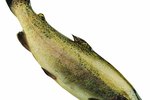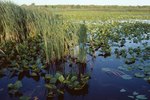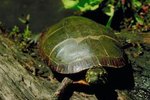
Alligator gars (Atractosteus spatula) are massive carnivorous fish that possess notably narrow physiques and visages that are strangely reminiscent of alligators, as their common names imply. Although alligator gars have somewhat ominous appearances, incidences of aggression toward human beings are undocumented. Their eggs are toxic to people, however.
Basic Information
Alligator gars, which are also frequently referred to as "gator gars," generally grow to mature lengths of between 4 and 6 feet. Especially tall specimens can get to 10 feet. Weight-wise, they generally are in the ballpark of 50 to 100 pounds, although some are as comparably enormous as 300 pounds. The upper portions of their bodies are brown or greenish-gray, while their lower parts are paler -- think white or yellow. Fish makes up the bulk of their diets, although they're opportunistic diners that typically take whatever they can get, whether blue crabs, tiny turtles, amphibians, ducks, decaying corpses or wee mammals. As far as fish go, gizzard shads are one of their main dietary staples.
Geography
The alligator gar haunting ground consists mostly of the southeastern and southern portions of the United States, heading a little into the Midwest. These fish reside in the waters of states such as Alabama, Georgia, Florida, Oklahoma, Arkansas, Illinois, Kentucky, Ohio, Missouri and Tennessee. Many of them also inhabit the state of Veracruz in Mexico. Some alligator gars have also been spotted as far down south as Central America's Nicaragua.
Getting to South Carolina
Alligator gars once in a while pop up in geographic locations that are outside of their normal range. A single alligator gar was retrieved in Lake Wateree, a South Carolina reservoir. This occurred in the summer of 2010. The lone alligator gar was believed to have arrived in South Carolina after being released from a private aquarium. Alligator gars are relatively prevalent in aquarium environments. Another sole alligator gar was also taken from a California reservoir called Clifton Court Forebay years earlier, in September 1991. Just as with the South Carolina alligator gar, this individual is also thought to have come from an aquarium.
Native Habitat
In terms of habitat preferences, these freshwater fish are fixtures in environments including bayous, rivers, estuaries, bays, oxbows and sizable lakes. They also are extremely common in damp and boggy locales. Alligator gars generally gravitate toward rivers that are sluggish and calm, however.
References
Photo Credits
-
George Doyle/Stockbyte/Getty Images




